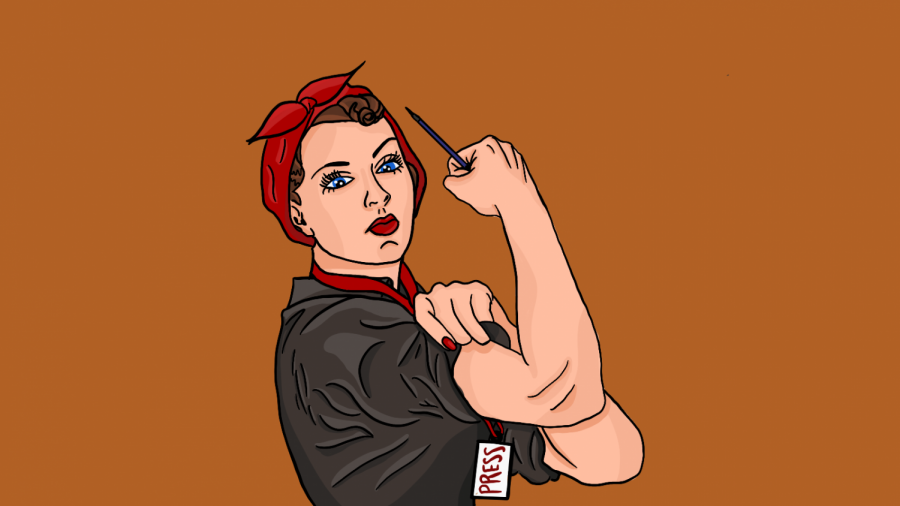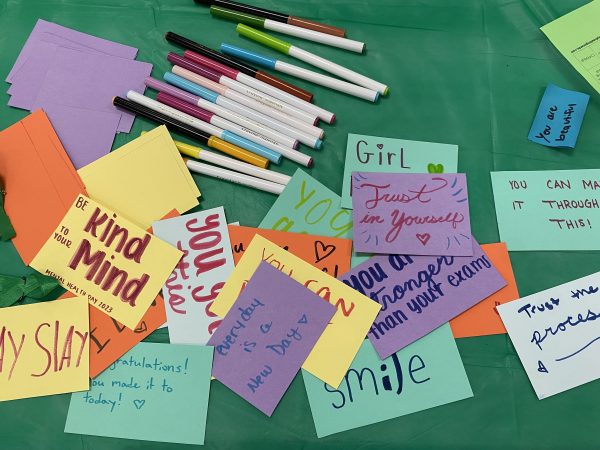OPINION: Seek truth and dismantle sexism in newsrooms
Photo credit/ Autumn Bohner
The iconic Rosie the Riveter image debuted in 1942 to demonstrate the revolution that women were creating in the workforce during World War II. Now Editor-in-Chief Briana Ryan it is time to take this revolution to the newsroom.
March 25, 2021
I love being a journalist.
I love the rush of adrenaline that pushes through my veins when I write a breaking news story. I love how my stories can prompt changes in my community. But what I love the most about being a journalist is the comradery that comes with being a part of a newsroom.
I often say that being a journalist is like being a part of the world’s greatest club. I have been fortunate to work with reporters who have built me up to become a stronger journalist. I have also been fortunate to be respected by my colleagues because of the content of my work. However, I am fully aware that not all newsrooms are like this.
Last year the Bill and Melinda Gates Foundation commissioned a report that examined the lack of women represented in newsrooms. This report found that men maintained 73% of the top management positions in newsrooms. The report also showed that men held 64% of reporting jobs.
The truth is that the world’s greatest club is also a boys’ club, but this creates a much larger issue because the lack of representation of women in newsrooms can trickle down into the content.
Journalists influence the news stories that are covered. So when most journalists working in a newsroom are male, that increases the chance that news subjects and witnesses will also be male. Frankly, it is irresponsible for newsrooms to create a culture where female narratives are diminished.
For those women who break through the hiring gap, they encounter a whole new gap.
The gender pay gap has been a consistent issue in all career fields. The United States Census Bureau data from 2019 found that women earned 82 cents for every $1 men earned.
In 2016, Voices, a student program from the Asian American Journalists Association, published a collection of studies that were commissioned by six newsroom unions to examine pay gaps. These studies concluded that the gender pay gap is alive and well in newsrooms.
Historically, salaries represent the value of one’s work. So when women earn less than men, it signals that their work is not as valued. This devaluation is not good news for morale.
Journalists provide an amazing service by shining a light on issues that matter to the community. Reporting often means sleepless nights and way too much caffeine. As journalists, we do this because we care about informing our community on issues. But it is difficult to keep productivity high when your paycheck doesn’t reflect your worth in the newsroom.
Journalists face dangers at every turn, whether it be covering a war or a protest. However, the real danger for journalists is lurking within their newsrooms.
In 2018 the Center for Talent Innovation (CIT) conducted a study that found that 41% percent of women in the media industry have faced sexual harassment during their careers.
Sexual harassment leaves journalists feeling unrespected, unworthy and damaged. Sexual harassment can also pose a safety risk. This lack of safety can lead to increases in absenteeism and increases in sick leave.
Absenteeism and sick leaves not only harm the financial health of newsrooms, but they can lead to communities receiving less coverage. This shows that sexual harassment in newsrooms impacts more than just the survivor.
So why should newsrooms care about equality? Let’s put basic humanity aside for a moment.
Sexism in newsrooms impacts us all. The news business is all about trust. If female journalists do not trust their newsrooms to respect them, how can readers trust them to provide honesty and truth?
Trust in journalism is at an all-time low, and newsrooms can not afford to have their readers think that their own reporters do not trust them.
I love being a journalist. I love being a journalist so much that I want to see newsrooms across the country create a better culture for female reporters and the communities they cover.
Contact the writer: [email protected]
Twitter: @BrianaRyanTWW














